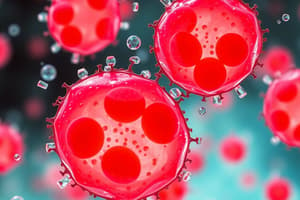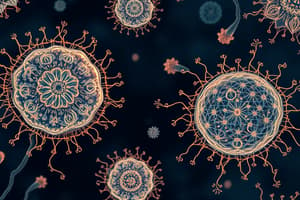Podcast
Questions and Answers
What is the main characteristic that distinguishes eukaryotic cells from prokaryotic cells?
What is the main characteristic that distinguishes eukaryotic cells from prokaryotic cells?
- The presence of multiple membranes
- The ability to perform photosynthesis
- The presence of a cell wall
- The presence of a clearly defined nucleus (correct)
Which organelle is responsible for generating energy in eukaryotic cells?
Which organelle is responsible for generating energy in eukaryotic cells?
- Mitochondria (correct)
- Lysosomes
- Golgi apparatus
- Endoplasmic reticulum
What is the main function of the cell membrane in animal cells?
What is the main function of the cell membrane in animal cells?
- To synthesize proteins
- To store genetic material
- To provide structural support
- To regulate the movement of molecules into and out of the cell (correct)
Which of the following is a characteristic unique to plant cells?
Which of the following is a characteristic unique to plant cells?
What is the function of the phospholipid bilayer in the cell membrane?
What is the function of the phospholipid bilayer in the cell membrane?
Which of the following is NOT a characteristic of prokaryotic cells?
Which of the following is NOT a characteristic of prokaryotic cells?
What is the function of lysosomes in eukaryotic cells?
What is the function of lysosomes in eukaryotic cells?
Which of the following is a characteristic of eukaryotic cells?
Which of the following is a characteristic of eukaryotic cells?
What is the primary function of the nucleolus?
What is the primary function of the nucleolus?
What is the main role of centrosomes in the cell?
What is the main role of centrosomes in the cell?
What is the function of lysosomes in the cell?
What is the function of lysosomes in the cell?
What is the composition of cytoplasm?
What is the composition of cytoplasm?
What is the function of the Golgi apparatus in the cell?
What is the function of the Golgi apparatus in the cell?
What is the main function of mitochondria in the cell?
What is the main function of mitochondria in the cell?
What is stored in the molecule produced by mitochondria?
What is stored in the molecule produced by mitochondria?
Why do different cells have different amounts of mitochondria?
Why do different cells have different amounts of mitochondria?
What is the main function of proteins embedded in the phospholipid bilayer of the plasma membrane?
What is the main function of proteins embedded in the phospholipid bilayer of the plasma membrane?
What is the term used to describe the cell membrane due to its ability to regulate the transport of materials?
What is the term used to describe the cell membrane due to its ability to regulate the transport of materials?
What type of proteins are found on the surface of the plasma membrane, allowing for cell-cell interaction?
What type of proteins are found on the surface of the plasma membrane, allowing for cell-cell interaction?
What is the function of the nuclear membrane?
What is the function of the nuclear membrane?
What is the term used to describe the structure of the nuclear membrane?
What is the term used to describe the structure of the nuclear membrane?
What is the function of the nucleus in a cell?
What is the function of the nucleus in a cell?
What is the term used to describe the array of holes in the nuclear membrane?
What is the term used to describe the array of holes in the nuclear membrane?
What is the function of the nucleolus, a sub-organelle found in the nucleus?
What is the function of the nucleolus, a sub-organelle found in the nucleus?
Which organelle is responsible for translating messenger RNA into a string of amino acids?
Which organelle is responsible for translating messenger RNA into a string of amino acids?
Which type of Endoplasmic Reticulum is involved in protein synthesis?
Which type of Endoplasmic Reticulum is involved in protein synthesis?
What is the primary function of the organelle with a high concentration of mitochondria in animal cells?
What is the primary function of the organelle with a high concentration of mitochondria in animal cells?
Which of the following organelles is composed of a thin, winding network of membranous sacs?
Which of the following organelles is composed of a thin, winding network of membranous sacs?
What is the primary function of the ribosome-studded surface of the Endoplasmic Reticulum?
What is the primary function of the ribosome-studded surface of the Endoplasmic Reticulum?
Which organelle is responsible for producing the energy required by the brain?
Which organelle is responsible for producing the energy required by the brain?
Study Notes
Cell Classification
- Cells are classified into two main categories: prokaryotic and eukaryotic
- Prokaryotes are single-celled microorganisms, include Bacteria and Archaea, and have a single membrane
- Eukaryotes have a clearly defined nucleus, nuclear membrane, and organelles such as mitochondria, Golgi apparatus, and lysosomes
Animal Cell Characteristics
- Animal cells are generally smaller than plant cells
- They have an irregular shape due to the absence of a cell wall
- They have only a cell membrane, whereas plant cells have a cell wall and a cell membrane
- Animal cells do not have chloroplasts, which are found in plant cells
Cell Organelles
Cell Membrane
- A thin, semipermeable membrane layer of lipids and proteins surrounding the cell
- Composed of a phospholipid bilayer that forms a stable barrier between two aqueous compartments
- Regulates the transport of materials entering and exiting the cell
- Provides protection and a fixed environment inside the cell
- Has proteins embedded within the phospholipid bilayer that carry out specific functions, including selective transport of molecules
Nucleus
- Contains DNA and other genetic materials
- Has a double-membrane structure called the nuclear envelope
- Has pores that allow for the selective passage of certain molecules into and out of the nucleus
- Contains a nucleolus that produces and assembles ribosomes
Centrosome
- A small organelle found near the nucleus with a thick center and radiating tubules
- Plays an important role in cell division
- Produces microtubules
Lysosome
- A membrane-bound organelle containing digestive enzymes that help in digestion, excretion, and cell renewal
Cytoplasm
- The gelatinous liquid that fills the inside of a cell
- Composed of water, salts, and various organic molecules
- Contains some intracellular organelles, such as the nucleus and mitochondria, which are enclosed by membranes that separate them from the cytoplasm
Golgi Apparatus
- A flat, smooth, layered sac-like organelle near the nucleus
- Involved in manufacturing, storing, packing, and transporting particles throughout the cell
- Processes and sorts proteins received from the ER for transport to their eventual destinations
Mitochondrion
- A spherical or rod-shaped organelle with a double membrane
- The powerhouse of a cell, releasing energy through chemical reactions
- Generates most of the chemical energy needed to power the cell's biochemical reactions
- Produces ATP (adenosine triphosphate) as a source of energy
Ribosome
- An intercellular structure made of RNA and protein
- The site of protein synthesis in the cell
- Translates messenger RNA (mRNA) sequence into a specified string of amino acids that form proteins
Endoplasmic Reticulum (ER)
- A cellular organelle composed of a thin, winding network of membranous sacs originating from the nucleus
- Has two forms: rough ER with ribosomes and smooth ER without ribosomes
Studying That Suits You
Use AI to generate personalized quizzes and flashcards to suit your learning preferences.
Description
Learn about the fundamental unit of life, cell structure, and classification into eukaryotic and prokaryotic cells in this zoology lecture for pre-medicine students.




